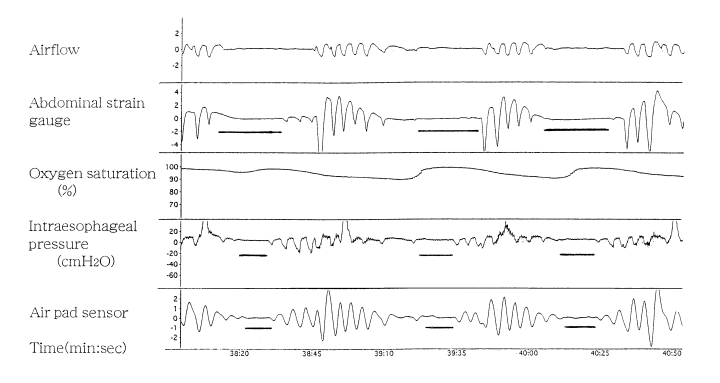Using an air-pad sensor for the diagnosis of sleep apnea: A trial study
Abstract
Abstract An air-pad sensor (APS) was developed to record respiratory effort non-invasively. The APS is placed under the subjects’ bodies and acoustic signals received by the pad are analysed. Nine patients with obstructive sleep apnea (OSA) and two healthy subjects were examined using an APS and daytime polysomnography, including intraesophageal pressure (Peso), simultaneously. The agreement ratio in terms of the central apnea time between the APS and the Peso was 93.4%, although the ratio between the Peso and an abdominal strain gauge was 40.7%. The agreement ratio in terms of respiratory rate among the Peso, APS, and abdominal strain gauge in patients with OSA was high; but the agreement ratio was low (74.4%) between the Peso and the strain gauge in mixed apnea.
INTRODUCTION
Chest and abdominal strain gauges are generally used for detecting respiratory problems during polysomnography. The data obtained from strain gauges are qualitative and their calibration may change markedly during the night. Intraesophageal pressure (Peso) monitoring is accepted as a quantitative method1 and as the gold standard for sleep studies; however, inserting a pressure transducer is considered to be slightly invasive for the patients. To correct this problem, an air-pad sensor (APS) was developed to diagnose the respiratory problems of subjects non-invasively.
SUBJECTS AND METHOD
The APS consists of three pads (measuring 20 cm × 60 cm × 1 cm) each containing 150 mL of air. The APS is placed under the subjects’ bodies or mattress during the examination. Acoustic signals received by the pad are converted to electric signals. Then the signals are filtered with 0.5 Hz low pass (80 dB/ decade) and analysed differentially.
Nine patients with obstructive sleep apnea (OSA) (nine men; average apnea and hypopnea index in supine position 56.0/h; average age 54.0 years; mean body mass index 26.6 kg/m2) and two healthy subjects (one man and woman; average age 26.0 years; mean body mass index 22.3 kg/m2) were examined using APS and daytime polysomnography, including intraesophageal pressure, simultaneously. The lines shown in Fig. 1 compare the agreement ratio in terms of the central apnea time among the APS, Peso, and abdominal strain gauge. Their sensitivity to detect the respiratory rate was also compared. Consecutive data during 10 min of sleep in a supine position was analysed.

. Respiratory recordings with an air-pad sensor (APS). The lines indicate central apnea periods, which were compared to evaluate the sensitivity among respiratory sensors. Note that the APS showed good agreement with intra-esophageal pressure changes, although the strain gauge could not differentiate the central from the obstructive period.
RESULTS
For the case shown in Fig. 1, mixed apneas were observed. Fluctuation of the APS showed good agreement with the intraesophageal pressure (Peso) in mixed apnea periods, but the abdominal strain gauge failed to differentiate the obstructive from the central apnea periods in this case.
Four of nine patients with OSA indicated obstructive and mixed apnea episodes. The remaining five patients showed only obstructive apnea. In four cases with mixed apnea, the agreement ratio in terms of the central apnea time between the APS and the Peso was 93.4%, although the ratio between the Peso and the abdominal strain gauge was 40.7%. In five subjects with obstructive apnea, the agreement ratios in terms of respiratory rate among the Peso and the APS, and the Peso and the strain gauge were 99.4% and 93.4%, respectively. In four subjects with mixed apnea, the agreement ratio was 97.5% in the APS and the Peso, and was 74.4% in the strain gauge and the Peso. Two healthy subjects showed complete agreement among the Peso, abdominal strain gauge, and APS.
DISCUSSION
A strain gauge, which is sensitive to length, consists of a sealed elastic tube filled with an electrical conductor. An understreched gauge may not produce a measurable change, and an overstreched gauge produces a high level of resistance. In addition, sensitivity may change with the sleeping posture.2 It is not easy to differentiate among the types of apnea (obstructive, central or mixed) when a strain gauge is used. Peso monitoring is accepted as the gold standard for evaluating respiratory effort quantitatively and is used as an A-class reliable sensor for polysomnography. The present study showed a high agreement ratio between the APS and the Peso in the central apnea period. If the APS is applied with strain gauges during polysomnography, the central apnea period may be identified easily. Recently, Ayappa et al. have reported that a nasal canula/pressure transducer provided a non-invasive reproducible detector of all events as esophageal manometry.3 However, the canula could not differentiate central apnea. Further studies on the APS is necessary to evaluate its reliability in various sleep-related breathing disorders and sleep positions.




